

WARNING LIGHTS AND CHIMES
Standard instrument cluster

Optional instrument cluster

Low fuel

Illuminates as an early reminder of a
low fuel condition indicated on the
fuel gauge. because The light comes on when
there is approximately 1/16th of a
tank indicated on the fuel gauge
(refer to Fuel Gauge in this chapter for more information). The ignition
must be in the ON position for this lamp to illuminate. The lamp will also
illuminate for several seconds after the ignition is turned to the ON
position regardless of the fuel level.
Service engine soon

Your vehicle is equipped with a
computer that monitors the engine’s
emission control system. This
system is commonly known as the
On-Board Diagnostics System (OBD
II). The OBD II system protects the
environment by ensuring that your vehicle continues to meet
government emission standards. The OBD II system also assists the
service technician in properly servicing your vehicle.
The Service Engine Soon indicator light illuminates when the ignition is
first turned to the ON position to check the bulb. If it comes on after the
engine is started, one of the engine’s emission control systems may be
malfunctioning. The light may illuminate without a driveability concern
being noted. The vehicle will usually be drivable and will not require
towing.
What you should do if the Service Engine Soon light illuminates
Light turns on solid:
This means that the OBD II system has detected a malfunction. but
Temporary malfunctions may cause your Service Engine Soon light to
illuminate. Examples are:
- The vehicle has run out of fuel. (The engine may misfire or run
poorly.) - Poor fuel quality or water in the fuel.
- The fuel cap may not have been properly installed and securely
tightened.
These temporary malfunctions can be corrected by filling the fuel tank
with good quality fuel and/or properly installing and securely tightening
the gas cap. After three driving cycles without these or any other
temporary malfunctions present, the Service Engine Soon light should
turn off. (A driving cycle consists of a cold engine startup followed by
mixed city/highway driving.) No additional vehicle service is required.
If the Service Engine Soon light remains on, have your vehicle serviced
at the first available opportunity.
Light is blinking:
Engine misfire is occurring which could damage your catalytic converter.
You should drive in a moderate fashion (avoid heavy acceleration and
deceleration) and have your vehicle serviced at the first available
opportunity.
Under engine misfire conditions, because excessive exhaust temperatures
could damage the catalytic converter, the fuel system, interior
floor coverings or other vehicle components, possibly causing a fire.
Airbag readiness

Momentarily illuminates when the
ignition is turned ON. If the light
fails to illuminate, so continues to flash
or remains on, have the system
serviced immediately
Safety belt

Momentarily illuminates when the
ignition is turned to the ON position
to remind you to fasten your safety belts. For more information, refer to
the Seating and safety restraints
chapter.
Brake system warning

Momentarily illuminates when the
ignition is turned to the ON
position, the engine is off and the
parking brake is engaged. If the
brake warning lamp does not
illuminate at this time, seek service immediately. Illumination after
releasing the parking brake indicates a low brake fluid level and the brake
system should be inspected immediately.
Anti-lock brake system (ABS)

Momentarily illuminates when the
ignition is turned to the ON position
and the engine is off. If the light
remains on, continues to flash, or
fails to illuminate, have the system
serviced immediately. With the ABS light on, the anti-lock brake system
is disabled and normal braking is still effective unless the brake warning
light also remains illuminated with the parking brake released.
Turn signal

Illuminates when the left or right
turn signal or the hazard lights are
turned on. If one or both of the
indicators stay on continuously or
flash faster, check for a burned-out
turn signal bulb. Refer to Exterior bulbs in the Maintenance and care
chapter.

High beams
Illuminates when the high beam
headlamps are turned on.
Anti-theft system (if equipped)

Refer to SecuriLocky passive
anti-theft system in the Controls
and features chapter.
Charging system
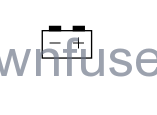
Illuminates when the ignition is
turned to the ON position and the
the engine is off. The light also
illuminates when the battery is not
charging properly, requiring
electrical system service.
Oil pressure/Engine coolant

This light will come on when the
the key is in the ON position and the:
• engine coolant temperature is
very high
• engine oil pressure is low
The light serves as a notice that a system needs your attention and to
check the engine coolant temperature gauge and the engine oil pressure
gauge.
Refer to Engine coolant temperature gauge and Engine oil pressure
gauge in this chapter for more information.
Transmission control indicator light (TCIL) (if equipped)

The word OFF located at the end
of the gearshift lever is the
transmission control indicator light
(TCIL).
The TCIL may flash steadily if a
malfunction is detected. If the TCIL is flashing, contact your Ford dealer
as soon as possible. If this condition persists, damage to the transmission
could occur.
Four wheel drive low (if equipped)

This light momentarily illuminates
when the ignition is turned to ON.
Illuminates when four-wheel drive
low is engaged. If the light continues
to flash have the system serviced.
Four wheel drive indicator (if equipped)

This light momentarily illuminates
when the ignition is turned to ON.
Illuminates when 4×4 range is
engaged.
Check air suspension (if equipped)

Illuminates momentarily when the
ignition is turned to the ON position
and the engine is OFF. The light also
illuminates when the air suspension
the system requires servicing.
For information, refer to the Air suspension system in the Driving chapter.
Door ajar
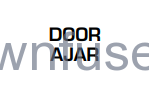
Illuminates when the ignition is in
the ON or START position and any
the door is open.
Fuel reset

Illuminates when the ignition is
turned to the ON position and the
fuel pump shut-off switch has been
triggered. For more information,
refer to Fuel pump shut-off switch
in the Roadside emergencies chapter.
Safety belt warning chime
Chimes to remind you to fasten your safety belts.
For information on the safety belt warning chime, refer to the Seating
and safety restraints chapter.
Supplemental restraint system (SRS) warning chime
For information on the SR’s warning chime, refer to the Seating and
safety restraints chapter.
Key-in-ignition warning chime
Sounds when the key is left in the ignition in the OFF/LOCK or ACC
position and the driver’s door is opened.
Headlamps on warning chime
Sounds when the headlamps or parking lamps are on, the ignition is off
(and the key is not in the ignition) and the driver’s door is opened

Fuel gauge
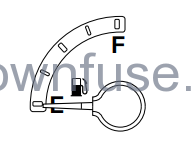
Displays approximately how much
fuel is in the fuel tank (when the
key is in the ON position). The fuel
gauge may vary slightly when the
vehicle is in motion. The ignition
should be in the OFF position while
the vehicle is being refueled. When
the gauge first indicates empty,
there is a small amount of reserve
fuel in the tank. When refueling the
vehicle from an empty indication, the amount of fuel that can be added will
be less than the advertised capacity due to the reserve fuel.
A minimum of six gallons must be added or removed from the fuel tank
in order for the gauge to instantaneously update. If less than six gallons
is the change, the gauge will take between five to ten minutes to update.
Speedometer

Indicates the current vehicle speed.
Engine coolant temperature gauge
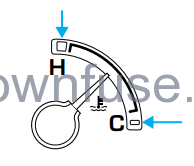
Indicates the temperature of the
engine coolant. At normal operating
temperature, the needle remains
within the normal area (the area
between the “H” and “C”). If it
enters the red section, the engine is
overheating. Stop the vehicle as
soon as safely possible, switch off
the engine immediately, and let the
engine cool. Refer to Engine
coolant in the Maintenance and
care chapter.
Never remove the coolant reservoir cap while the engine is
running or hot.
This gauge indicates the temperature of the engine coolant, not the
coolant level. If the coolant is not at its proper level the gauge indication
will not be accurate. If the gauge enters the red section, the oil
pressure/engine coolant and Check Engine/Service Engine Soon
indicators illuminate, refer to What you should know about fail-safe
cooling in the Maintenance and care chapter

Odometer
Registers the total kilometers
(miles) of the vehicle.
Trip odometer

Registers the kilometers (miles) of
individual journeys. Press and
release the reset button until a “T”
appears in the display (this
represents the trip mode). Press
and hold the button for 2.5 seconds to reset.
Tachometer

Indicates the engine speed in
revolutions per minute.
Driving with your tachometer
pointer continuously at the top of
the scale may damage the engine.
Battery voltage gauge

This gauge shows the battery
voltage when the ignition is in the
ON position. If the pointer moves
and stays outside the normal
operating range (as indicated), have
the vehicle’s electrical system
checked as soon as possible.
Engine oil pressure gauge
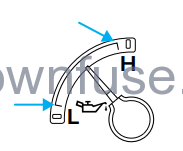
This shows the engine oil pressure
in the system. Sufficient pressure
exists as long as the needle remains
in the normal range (the area
between the “L” and “H”).
If the gauge indicates low pressure,
stop the vehicle as soon as safely
possible, and switch off the engine
immediately. Check the oil level.
Add oil if needed (refer to Engine oil in the Maintenance and care
chapter). If the oil level is correct, have your vehicle checked at your
dealership or by a qualified technician.
